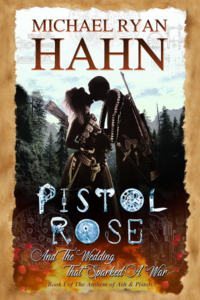

Description Pistol Rose and the Wedding that Sparked a War by Michael Ryan Hahn
As a young wilderness girl, Pistol Rose knows nothing of the advanced Strelkie City or the mad king Ward Harrol who sits behind its walls. She doesn't understand why the Strelkie forbid marriage.Buy Pistol Rose and the Wedding that Sparked a War by Michael Ryan Hahn
AmazonPistol Rose Guest Post for Melissa’s Must Read
Faster
How to Write by the Seat of your Pants: Outline or No?
Half of me is a massive fan of
outlining. It all begins with an idea of a theme or an argument (that I keep
quite secret and to myself), as a kind of story motivator. I wouldn’t call it a
“moral of the story,” it’s a little more buried than that. And I don’t bother
hoping that people will discover it, it’s more like a holy relic locked in an
altar if I’m feeling lofty, or a joke written on a scrap of paper and buried in
concrete if I’m feeling, well what’s the opposite of lofty, bunkery? It’s there
for me alone. The seed of the apple tree. If I have that little nugget stowed
in my pocket, then every strain of story that appears can more readily connect
to it. And for some reason, that just feels better to me than
reverse-engineering it. It’s a litmus test to know if an arc or a subplot or
whatever belongs.
Naturally, I break the litmus test
half the time, and wrestle over whether something should be allowed to belong
despite its failure to adhere to form. Maybe half of my well-intended plans
make it into the outline? The outline is an arranged marriage between feelings
and action beats, something like a movie in a lot of ways. And once I’ve thought
about the story for a month or so, the outline itself takes a day. It’s
important to me to write it all out in a single day, if I can. Sometimes it
takes two or three. But the faster the outline materializes, the more alive the
story feels. I like to see it all at once.
I tend to write one paragraph per
planned chapter. Ideally, each planned chunk will tangle with the Big Stakes
that I set out at the beginning of the outline, so everything is moving forward
all the time. That paragraph, and sometimes it’s more than one, serves as a
kind of writing prompt more than an instruction list. I can write about one
chapter in a sitting, 10 to 20 pages, and a good prompt can fuel that through,
for the most part.
Often, I’ll get about halfway
through the outline, have all these grand plans and intricate designs, and then
some character will decide to up and wreck everything. Change of plans. Or it
will become clear that it is quite time for this character over here to die for
his crimes, and that alters the plan for what follows, somewhat. That’s the
half of me that doesn’t like outlining. The half that wants an organic
surprise. I’ve written chapters where I didn’t know how it was going to end…
and been so thankful I had that outline to run back to, crying with my bruises,
to guide me back on track.
The balance seems to be in having a
well-thought-out plan and in having the freedom to roam from it. Like being an
outdoor cat who likes to sleep inside at night. Whether they admit it or not, such
felines are never short on pride or humility, which makes for an adventurous
combination.
The particular outlining and
cobbling-together of this first Pistol book is actually even a little
different than my writing process as a whole. It started as a screenplay. Maybe
it will reach the screen one day, but I was drawn to the idea of fleshing out
the story in book form right now. A lot of people have asked how on earth you
can turn a script into a book, because it seems so hard when the training for
one mode is so different from the other. The answer is I just did it in layers.
Baby steps. I led with what was familiar to me. First was a direct
transposition of the script, then a writing pass adding all the direction (action)
I might explain if I were filming it, then another pass putting in all the set
and art direction, then a dialogue sweep and an inner thoughts sweep, and a
point of view controlling sweep to avoid head-hopping as much as possible… and
this all of course led to a fine mess.
But then there were bones that
almost looked like a book. It didn’t feel organic yet. So, then it was
off to the revisions, adding and cutting until a unifying feeling took over, and
with a little time, it all came together and made sense. It was like building a
house and then deciding to rotate the house ninety degrees, by hand, with the
wrong tools.
Which was great, because after
going through that, the next writings I’ve done have been much, much faster,
and from those, the process I explained above grew.
I suppose you could say that I
outline by the seat of my pants.
© Michael Ryan Hahn


No comments:
Post a Comment
Thanks for visiting!